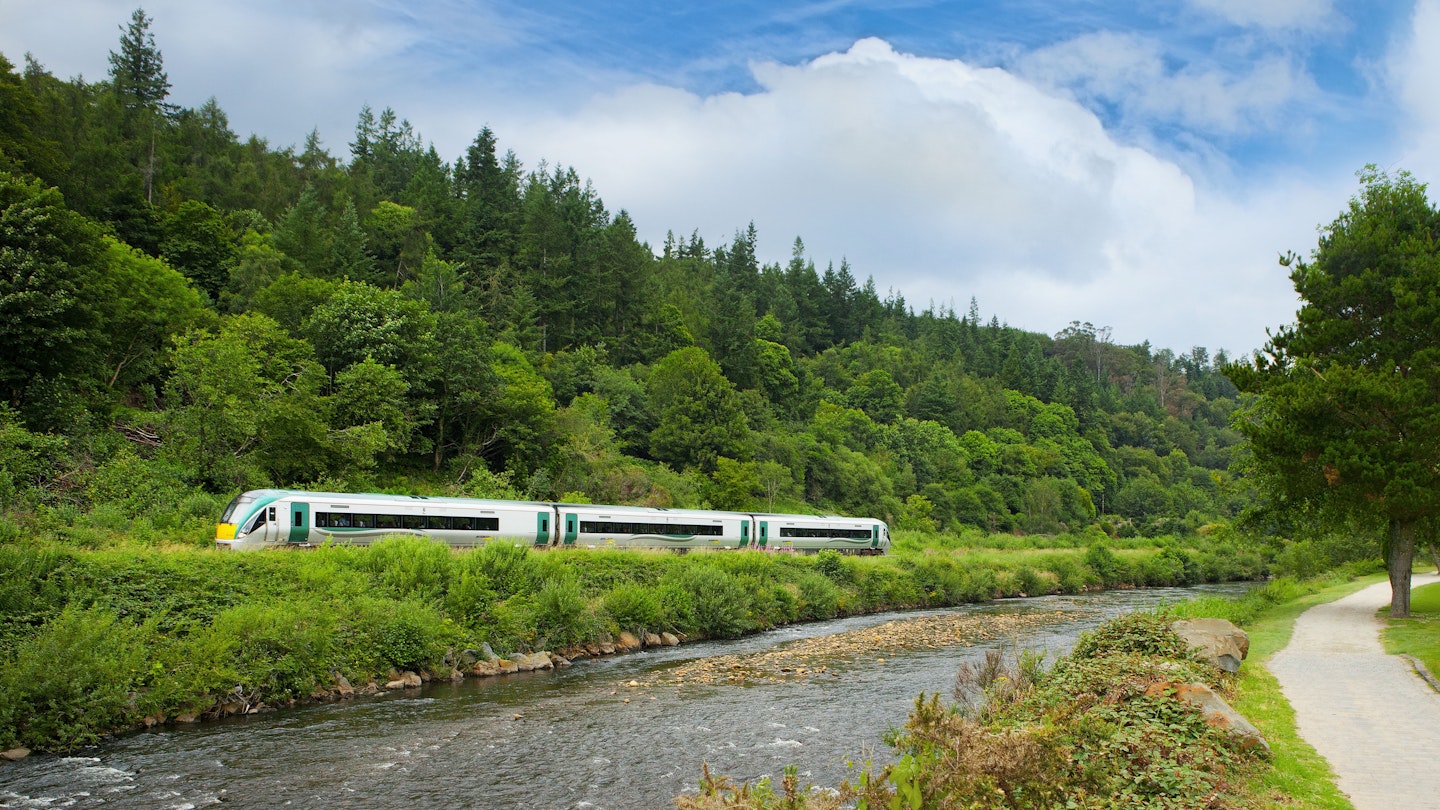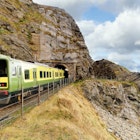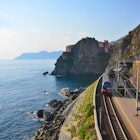Traveling by train is one of Ireland’s great, if under-appreciated, pleasures.
It’s a small island and the rail network is limited, so no journey is especially long – but riding the rails across the country is one of the loveliest ways to enjoy the rolling countryside.
Compared to its European counterparts, Irish trains aren’t especially spectacular, but this is a country that doesn’t need high-speed or sleeper trains: you roll along at a maximum of 160km/h (99mph) and before you know it you’re on the other side of the island.
The particular nature of Irish demographics has shaped train travel in Ireland: with around a quarter of the population clustered in the greater Dublin region, it makes sense that most train journeys begin or end in the capital. In Northern Ireland the same is true of Belfast.
Irish trains might not be especially quick or super luxurious, but they’re an efficient and eco-friendly way of exploring the island – so long as your explorations are focused on the major cities and towns. Here is our essential guide to train travel in Ireland.
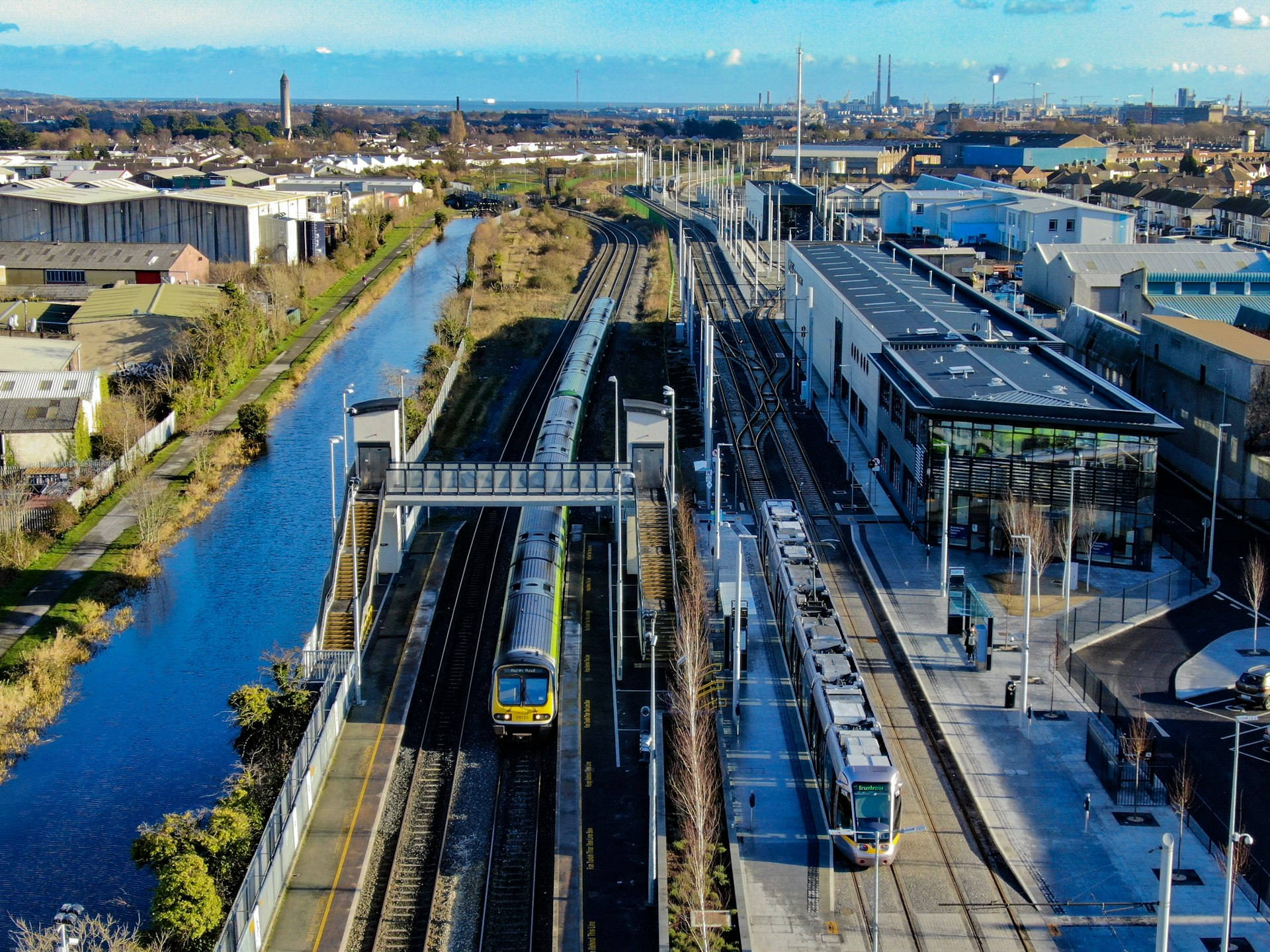
The lowdown on rail travel in Ireland
Irish trains are efficient, relatively frequent and usually on time. Irish Rail/Iarnród Éireann operates the entire network of trains in the Republic, from intercity trains linking the major urban centers to the busy commuter network that services the greater Dublin region.
There are two main lines into the west and three into the south and southwest; spurs off the main lines connect to a host of smaller towns throughout the country. There’s also a line to Belfast, from where Translink services connect the city with the Antrim Coast and Derry (Londonderry).
Within the greater Dublin region, a network of commuter services connects the capital with a host of suburbs and dormitory towns in the surrounding counties. Dublin’s coastline between the northside suburbs of Howth and Malahide, and Greystones in County Wicklow is served by DART (Dublin Area Rapid Transport) trains.
There are some notable gaps in the country’s rail network, with no services in counties Donegal, Monaghan and Cavan, and no trains into West Cork. Some towns – like Buttevant in Cork or Annacotty in Limerick – are on the rail line but they’re bypassed as they have no functioning station.
Ireland’s bigger train stations – including Cork, Limerick, Galway, Sligo, Belfast and the two in Dublin – are all pretty well stocked when it comes to picking up supplies and other assorted sundries for your journey. Most other stations will have a small shop.

Train tickets are relatively good value
The good news about traveling by train in Ireland is that it is relatively inexpensive compared to train travel in some places, such as the UK, for example. If you buy it online, a standard one-way fare between Dublin Heuston and Kent Station in Cork costs €30–35, and around €55 in first class.
Online is the best place to buy your tickets for train travel in the Irish Republic. Not only do you get the best fares (with savings of up to 50% compared to buying the ticket at the station), but you can purchase your ticket up to 90 days in advance and reserve a seat when you do.
You have the option of collecting your bought ticket from a machine at the station as you’re boarding, or downloading a QR code at the point of purchase. If you wait to buy your ticket at the station, you’ll pay significantly more and have to get there early to queue up at the ticket kiosk.
For travel in Northern Ireland, you’re better off buying the ticket at the station as only a limited number of tickets are available online. Show up a short time before your intended departure time and just buy your ticket there.
Only a handful of services offer first class, but upgrading is relatively inexpensive. On average, expect to pay around €20–25 more to sit in first. There are three kinds of first class service on Irish trains. CityGold is on direct Dublin to Cork services, and includes an onboard host and a complimentary newspaper on selected early morning services. The Enterprise service between Dublin and Belfast offers the same, plus a fine breakfast. Premier Class is similar, but is only available on direct services between Dublin and Tralee and some Dublin to Cork trains.

Some discounts and offers apply
There are discounted fares for children and young adults aged between 19 and 25, as long as they have a valid discount card. Under fives and those aged 66 and over travel for free.
The commuter network in the Greater Dublin area has a fare cap of €6 for travel between the capital and a host of towns in the surrounding counties.
There are two rail passes aimed at visitors. The Trekker Four Day (€88) offers unlimited travel for adults on all Irish Rail services on four consecutive days from the date of issue. The Explorer (adult/child €128/64) provides five days of travel on all services in a 15-day window.
However, before investing in either, be sure that you plan on making the most out of it. The limited rail network means that connections are limited and traveling between some destinations involves backtracking: Cork and Waterford are both on the south coast, but to get from one to the other means travelling to Limerick, while Sligo and Westport are only 140km (87 miles) apart along the west coast, but to go between them by train you’ll have to travel through Dublin – which is on the other side of the country.
In Northern Ireland, the Sunday Fun Day Tracker ticket gives passengers unlimited train travel on a Sunday for £9 (£4.50 for children). Tickets are available from all ticket offices, the mLink ticketing app and from the conductor on the train.
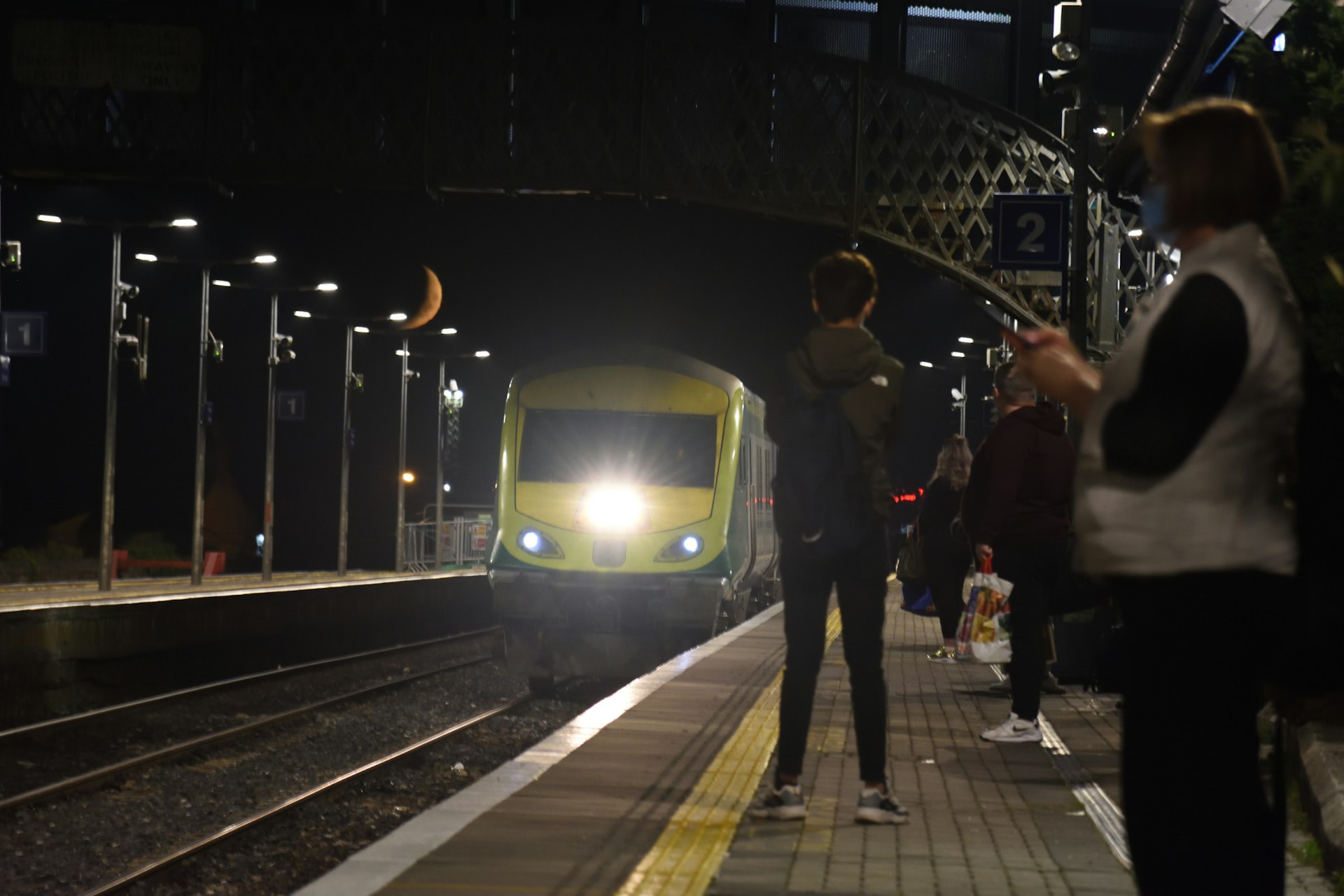
These are the busiest times to travel by train
Unsurprisingly, peak times for train travel coincide with busy rush hour periods. Early morning services to Dublin from cities including Cork, Galway and Limerick can be busy, especially if the train is due to arrive in Dublin around the start of the working day. Friday evening trains departing Dublin can also be quite busy. However, as online bookings also include the option of booking a seat, you’ll never have to stand.
The commuter network is busiest on weekdays from 7am to 9am and from 4:30pm to 6:30pm as thousands of people travel in and out of work. You can’t prebook seats on these services, so plenty of people do end up standing. Keep an eye out on changing schedules, especially for weekend and holiday travel, as frequencies diminish.
The train network is limited, but it has some benefits over road travel
There are no rail links to any Irish airport, which means you’re relying on taxis, private cars or buses once you arrive in the country. Irish ferry ports are better connected to rail lines, however, and you can catch trains in Rosslare, Dublin and Larne; there is no rail link to Belfast Port.
If you want to reach the more remote corners of the island, then the Irish rail network is quite limited, and a car will give you the flexibility you need. However, rental fees can be very expensive and fuel is another considerable cost, with the price of unleaded and diesel hovering between €1.75 and €2 a liter. Parking is also pricey in all urban centers, especially Dublin.
Traveling by bus is the cheapest way to get around, but it can be a slow business, as most make lots of stops along the way. There are some direct express services, but they are at the mercy of traffic, which can also add considerable time to a journey compared to traveling by train. Plus, buses don’t have bathrooms, with those traveling longer distances relying entirely on rest stops.
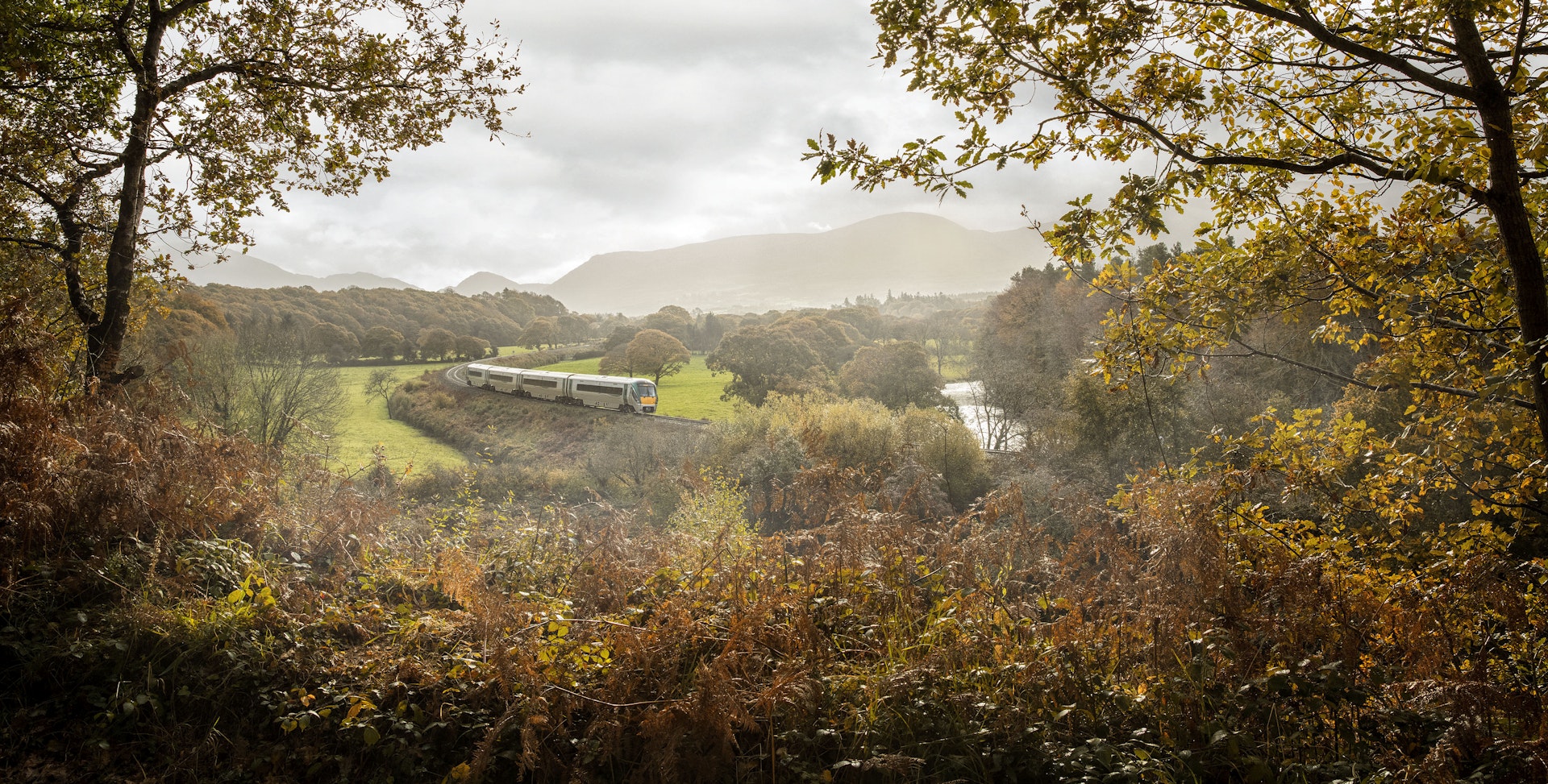
On board facilities vary depending on the type of train
There are two kinds of Irish trains: InterCity and commuter. InterCity trains are all the same – relatively modern with comfortable seats in standard class and fancier recliners in first – and they travel at speeds of up to 160km/h (99mph). There’s no journey in Ireland that is longer than 2½ to 3 hours. Commuter trains are slightly older, with less comfortable seats; older trains are used on some small-distance spur lines in rural areas and are very basic (facilities include seats and a toilet).
While Ireland’s flagship service is the one between Dublin and Cork, the fanciest train is the Enterprise service between Dublin Connolly and Belfast Lanyon Place, which is a joint venture between Irish Rail and Translink. This train is on a par with most services you’ll find in mainland Europe and first class is the most luxurious of any in the country.
All InterCity trains have three-pin sockets at every row where you can plug in a charger or a laptop. Most commuter trains in the greater Dublin area also have sockets. All trains have toilets and there is a cross-network wi-fi service operated by Irish Rail, but it is patchy and inconsistent. Translink has its own wi-fi network, which is accessible on all bus and rail services in the north, but, like in the Republic, you’re at the mercy of signal strength and contention levels.
Food options are pretty limited. There is a trolley service on the Dublin to Cork service, while the Enterprise between Dublin and Belfast operates a full service menu in a dedicated dining car; first class passengers also get a pretty good breakfast as part of their ticket.
Some trains on the Dublin to Cork route have a “quiet carriage” (usually Carriage G, marked in purple when booking) where the use of phones is prohibited and passengers are encouraged to keep noise levels down.
You can bring a bike on any Irish Rail train for free, although there are some restrictions during busy periods (such as sporting fixtures and concerts). The Dublin to Cork line is the only one to have a dedicated bike storage area; all other InterCity trains have (very) limited bicycle spaces within the passenger compartment – it’s not unusual for only two bikes to be allowed into the compartment, so be sure to book in advance. Bikes are not allowed on commuter and DART services during peak hours – before 10am and from 3:30pm to 7pm Monday to Friday.

There are many scenic train routes: here are the best
No matter where you are in Ireland you’re going to find a beautiful landscape or two, but some journeys are worth keeping your eyes wide open for.
Dublin to Sligo
Once you’ve gone past the huge suburban sprawl of the greater Dublin area, the landscapes get quite gentle; beyond Mullingar the train skirts alongside the edge of beautiful Lough Owel. For the best views, sit on the left-hand side of the train.
Dublin to Belfast
The Enterprise service is the best in the country, with the most comfortable seats and the best food options – especially in first class. The train skirts alongside the Irish Sea between Malahide and Balbriggan, so be sure to sit on that side as you travel (on the right-hand side if you’re traveling to Belfast).
Derry (Londonderry) to Coleraine
The Translink service between Northern Ireland’s second city and Coleraine is a stunner, a 40-minute journey along the Causeway Coast that comes with beautiful beaches, huge cliffs and unimpeded views out over the North Sea.
Downpatrick to Inch Abbey
It’s only a 10-minute journey, but the trip from Downpatrick in County Down to the monastic ruins of Inch Abbey takes place in a vintage steam train (or a 1960s diesel train) that chugs its way along the line, over the River Quoile and past the drumlin-specked landscape.
Cork to Cobh
One of Ireland’s most scenic trips is the 25-minute trip from Cork City to the seaside town of Cobh, which takes you along the river (sit on the right for the best views), past marshy Harper’s Island and over the bridges on Lough Mahon and the Slatty Water. You can always stop off at Fota and visit the wildlife park there.
Book in advance for wheelchair access to trains
All InterCity services are nominally accessible, but if you do need assistance you will need to book it in advance so that suitable arrangements can be made. This usually means that a conductor will have a ramp ready for wheelchair access, but we have also heard plenty of anecdotal evidence of staff simply lifting a wheelchair onto a train, which depending on the individual can either be a help or an annoying hindrance. Whatever you do, make sure to communicate your requirements before you travel as assistance is not guaranteed otherwise.
For passengers with learning difficulties or any issue where there may be a challenge with communication (such as autism) Irish Rail staff are trained to recognize visual cue cards such as the JAM card, which inform the interlocutor of the holder’s condition. JAM cards are available online or at mainline train stations in Dublin, Cork, Galway, Limerick, Waterford and Sligo.
